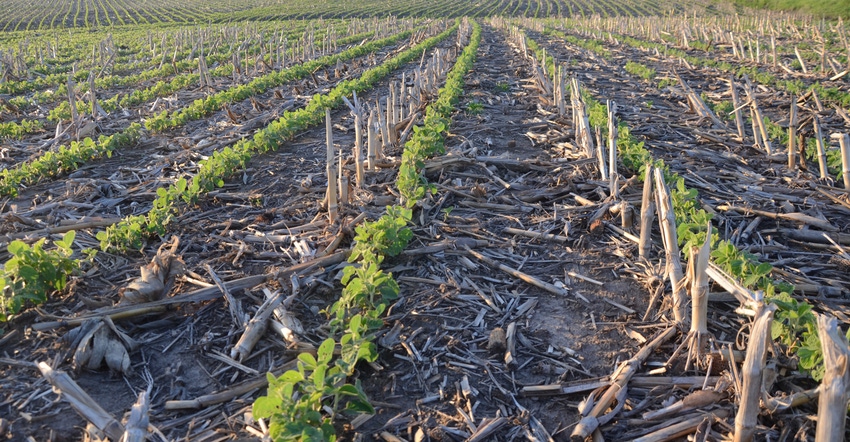
Soybean seeding rates are a popular topic of discussion in Nebraska. Over the past 10 years, growers with the Nebraska On-Farm Research Network have compared different soybean planting populations.
Over time, growers in the eastern part of the state gradually have reduced populations from about 160,000 seeds per acre to 100,000 seeds per acre or lower.
Of course, most new planters are variable-rate capable, and more farmers can use variable-rate seeding with soybeans compared with 10 years ago. While not all fields are suited to variable-rate planting, one of the most difficult questions to answer is: How do you make the prescription and designate zones?
At the recent Crop Management Conference in Kearney, Neb., Laura Lindsey, soybean and small grain specialist at Ohio State University, highlighted findings on variable-rate soybean planting from recent on-farm research in Ohio.
Nebraska and Ohio greatly vary when it comes to climate, elevation, soil type and other growing conditions. But regardless of whether you're in Ohio or Nebraska, it's best to have consistency within each zone in the prescription — and that consistency differs depending on the field and how boundaries are set.
"What works to make uniform zones in one field isn't the same in another field,” Lindsey says. “That makes it challenging.”
For example, at one central Ohio site in 2017, soybeans were planted at an ideal time May 17. Prescriptions were made based on soil map units through the Natural Resources Conservation Service’s web soil survey, with seeding rates ranging from 140,000 to 180,000 seeds per acre.
In this case, yield increased with higher seeding rates — at 65 bushels per acre with 180,000 seeds per acre, compared with 52 bushels at 140,000 seeds.
But how effective was this method for creating zone boundaries?
As part of this study, Ohio State evaluated the effectiveness of different factors used to designate zones using postharvest yield data and calculating the Local Ideal Seeding Rate for each plot. Different methods, including grid soil samples, soil map units and terrain derivatives were evaluated using what's called a random forest model to rank the importance of the variables in creating zones.
"Soil map unit had the highest error rate,” Lindsey says. “That means when the farmer used soil map unit, it was prone to error in the sense that those zones were not homogeneous. I think it's a resolution or scale issue — those maps aren't meant to work on a field scale. When we took grid soil samples, we took one every half-acre. With soil maps, there's more interpolation and modeling. You're not digging a soil pit every half-acre in the field."
With grid soil sampling, two common variables, potassium and pH levels, were found to be effective for creating prescriptions, and ranked high compared with other variables studied. However, Lindsey notes in fields where potassium deficiencies or low pH were a factor, they varied across the field.
"Instead of correcting a low pH problem with seeding rate, it would be better to just correct the pH problem,” she says. “The same thing for potassium. When potassium worked as a way to make zones, it's because potassium was low in some areas of the field. And applying fertilizer would be better than fixing that with seeding rate. I think grid soil sampling has a lot of value from a variable lime or variable fertilizer aspect. For variable-rate seeding, I'm less confident."
Terrain derivatives work better for creating homogeneous zones, Lindsey says — they don't change year-to-year. Depending on the site, the study showed a high accuracy for setting zone boundaries based on terrain derivatives such as elevation, valley depth, aspect and hill shade.
Keep in mind this data comes from a single year's research, and results varied depending on the location. When creating a prescription and delineating zones, no two fields are alike.
"The important factors to create prescriptions vary field by field,” Lindsey says. “There's not one way that's going to work for everyone. The best way to fine-tune this is through on-farm research. Trying some of these methods and seeding rate trials on-farm is one of the best ways to learn."
Plant density affects architecture
At another on-farm research site in central Ohio in 2017, soybeans were planted on time, April 27. Seeding rates ranged from 100,000 to 180,000 seeds per acre, all on 15-inch rows. However, heavy rainfall right after planting reduced final stand counts — an average of 73,000 plants per acre — on a field with a seeding rate of 142,000.
"What's really interesting about this field is it was the highest yielding out of the four," Lindsey says. "His field average was 62 bushels per acre. If he had not been working with us, I think he would have replanted."
Lindsey notes individual plant architecture changed because of this lower stand. This resulted in more lateral branches with more pods, thicker stem diameters and lower plant height with a lower height for the lowest pod.
However, these lower populations, with lower plant height, also saw greater harvest losses. Lindsey notes within that 62-bushel-per-acre field, within 1 square foot, there may be 20 seeds — about a 5-bushel-per-acre loss.
"We think a lot of it had to do with plant height,” Lindsey says. “He had a lot of short plants, and when you have shorter plants, your lowest pod height is closer to the ground. So, we think he missed a lot of soybeans."
About the Author(s)
You May Also Like






